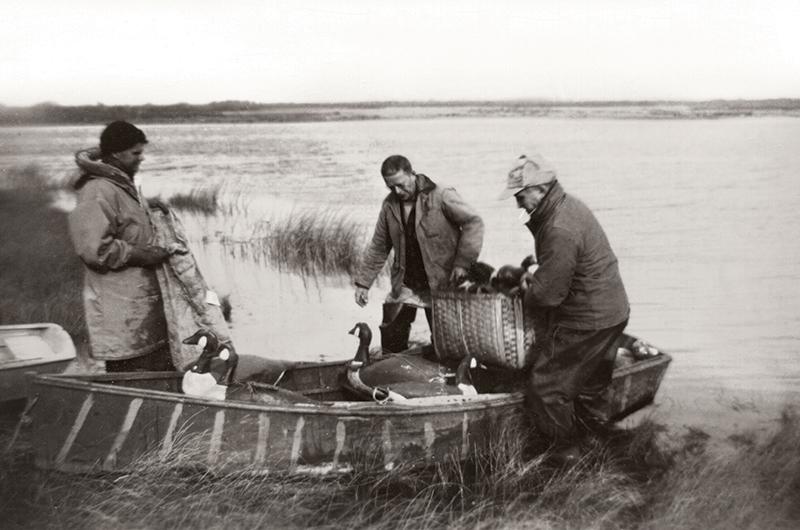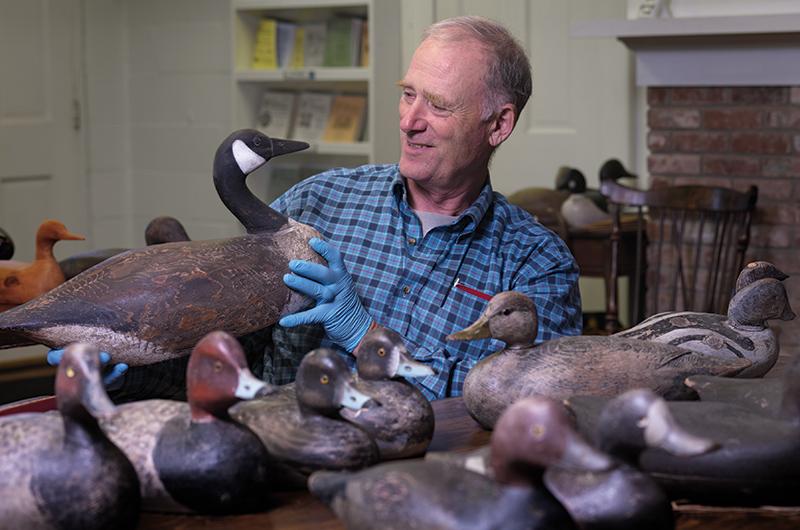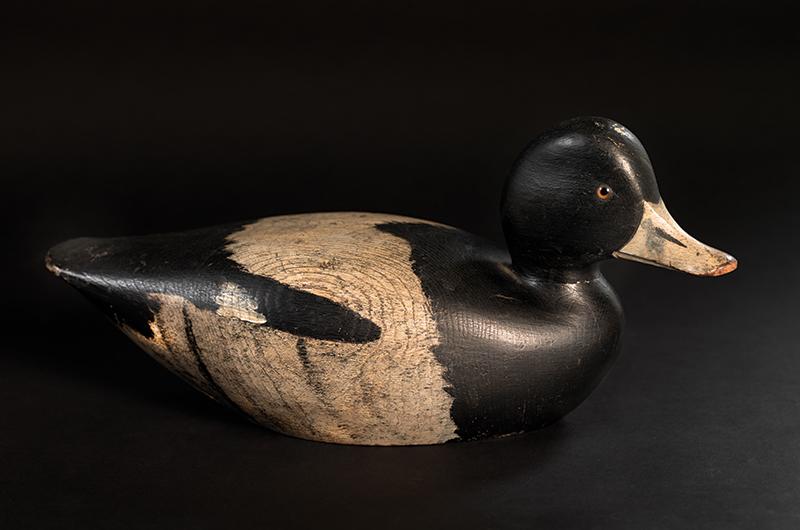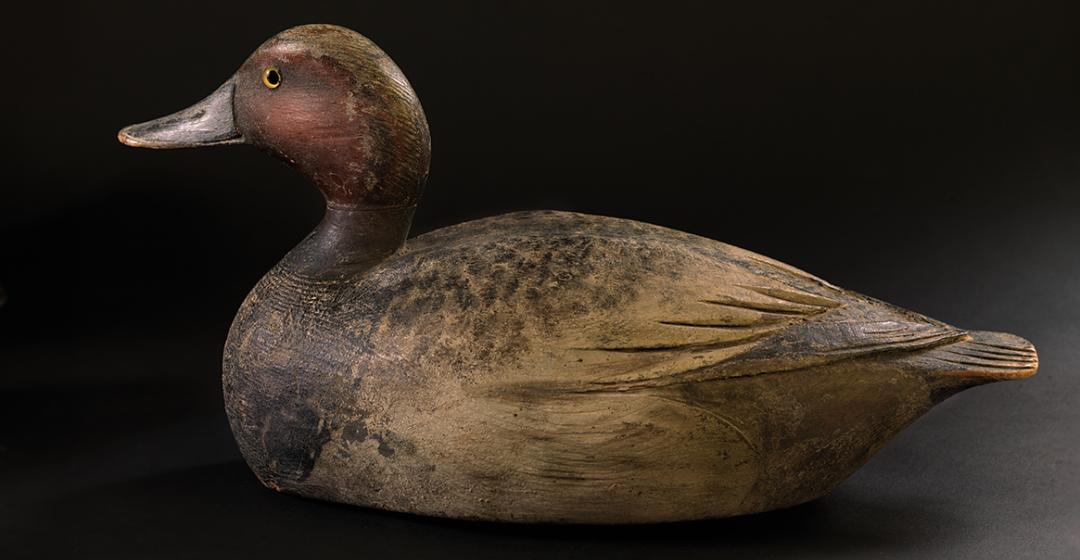The sport of duck hunting can be traced back thousands of years to Native Americans who would use clumps of reeds and cattails or even other dead birds to attract a duck. After the invention of shotguns, hunters interested in the commercial aspects of hunting wanted better, more realistic ways to lure the birds close enough to shoot greater numbers of them. Welcome to the beginning of wooden duck decoys.
The late West Tisbury artist and author Stan Murphy described handmade decoys in his book Martha’s Vineyard Decoys: “[Duck decoys] were made only to toll the birds, not to leave for posterity the evidence of man’s ability to create from common materials things of truth and occasional great beauty.” Now these fascinating wooden models have become folk art.

Early in November, the Martha’s Vineyard Museum in Edgartown opened an exhibit called the Art of the Hunt. “We chose the cream of the crop from the forty-plus decoys we have,” says chief curator Bonnie Stacy. The decoys showcase Island carvers of the late nineteenth and early twentieth century, most of whom carved decoys for hunting, not for artistic value.
Though the museum hosted a decoy exhibition a few years ago, this new show offers a more in-depth look at decoys and the people who carved them, including photographs, oral histories, and more. “We want to integrate more history into it...profile the hunter as well as the decoy,” says assistant curator Anna Carringer.
Many hunters carved for their own personal use, and a few people carved for others. H. Keyes Chadwick, who lived in Oak Bluffs and died in 1958, was known as a prolific decoy creator. “He was the only serious guy who made them for sale,” says Chris Murphy, Stan’s son, an avid decoy collector who occasionally carves them himself, and a co-curator for the museum exhibit. Originally carving for leisure, Chris explains, Chadwick got serious after he was injured at his carpentry job, leaving him with more time to carve. His neighbor Ben Smith was also a carver, and Chadwick sharpened his skills learning from him.

Stan described in his book that although the two men carved the same product, their finished decoys couldn’t have been more different. Ben Smith declared that he made the decoys for the ducks, not the men who used them. Smith focused on making the decoy look as realistic as possible – lively and alert. Chadwick, on the other hand, created decoys that Stan described as stately, with a gracefulness and smooth finish.
Regular decoy carvers were able to work quickly. The longest part of the process was setting white cedar posts outside to cure for a year before use. The white cedar became the body, and sugar pine, which holds detailed carving more easily, was used for the head. Once both parts were complete, the head and body were screwed together.
The carver then had to balance out the decoy, usually by quickly nailing on weights. Chadwick had a unique way of adding weight: He would bore a wide, shallow depression in the base of the duck along the long axis, drive a nail into the center of it (to act as an anchor), and fill the depression with melted lead until it was flush with the bottom of the decoy. To tell if a decoy is a Chadwick original, just flip it over and observe the weight.

Painting decoys required different skills than carving them. “For me personally,” says Chris, “I find it a lot harder to paint than to carve. So it might take me a day or two to carve one, but it might take me three days to paint it.” Chadwick was also a carver who knew his limits. When it came to painting, he would send his decoys to Elmer Crowell in East Harwich. Stan wrote that the first time the two paired up, Chadwick pronounced the decoys to be the most beautifully painted ones he’d ever seen.
To float on the water, Chris explains, each decoy had a string attached to an anchor. The hunter would wade out into the water, unwrap the string, and drop the anchor to set the decoy down. As the hunter waited, hidden from view, the decoy would bob in the water and attract the attention of ducks flying above. The most popular bird that hunters wanted to attract was the scaup, better known on Martha’s Vineyard as the bluebill.
Bluebills came to the Island by the thousands during the fall, and if the winter were mild enough, stayed through it. Some years, though, there were more redheads than bluebills. To compensate for the change of bird, the hunters would simply paint the bluebill decoy’s head red. Chris says, “Physically these two birds were almost identical,” making the transition simple enough.

To attract certain ducks, such as a mallard or black duck, a hunter could set just a few decoys, but it was a different case for bluebills and other ducks known to fly in large flocks. The hunter would need a dozen or more. Many hunters turned to the Mason Decoy Factory in Detroit to buy in bulk – especially if they didn’t have the time or skill to carve, or the money to buy from people like Chadwick. Founded by William Mason, this factory was able to mass-produce affordable decoys. Chris says, “The Mason factory decoys were sort of the cheap thing you could get [anywhere] for three or four dollars and receive a dozen wooden decoys.”
Today, most duck hunters buy plastic factory-made decoys, but Chris says, “There are still a few purists [who] make and use wooden decoys.” The museum exhibit celebrates this conjunction of nature and art. As Stan put it, describing a decoy he had found buried in the dunes, “It was carefully hand-carved by someone who knew a great deal about birds, someone who went beyond craft and created a work of art.”





